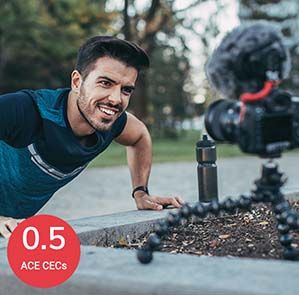
Let’s get down to business. The fitness business. Your business.
The first couple months of the New Year are a good time to reassess your career. After all, as much as you love being a health and exercise professional, you also want to make a living, and to do that effectively this will likely require tapping into a part of yourself you may not realize you have, an aspect of your character that—along with your love of the gym and helping people get stronger and fitter—probably got you into training in the first place.
“If you’re a trainer, there’s part of you that has to be entrepreneurial,” says Daniel Lucas, co-founder of Nimble Fitness in Manhattan. And, he continues, the best trainers are usually the most open, curious and committed. “[You’re] always working on a new skill, a new piece of equipment, a new way of doing something.”
That willingness to seek out more information, to always keep learning and growing, is a major factor in finding success as a health and exercise professional. If you’ve made it your goal this year to launch or expand your business, the 4 P’s of marketing—product, place, price and promotion—are a great place to start. It’s an organizational construct that invites you to look at the four key factors of any marketing strategy and decide how and in which ways you will maximize them to grow your business.
Let’s talk about each of these four as they relate to your health and fitness business:
Product
As a former executive with such companies as IBM and Bristol Meyers Squibb—and a dedicated fitness enthusiast—Lorraine Marchand, author of The Innovation Mindset: Eight Essential Steps to Transform Any Industry, evaluates personal trainers the way she might look at a new medical technology or pharmaceutical product. “To me, the product the trainer is offering is their personal, customized program to help me achieve my fitness goals and take my workout to the next level,” she explains. “That’s a strong value proposition for an avid workout person like me.”
With so many competent trainers out there who provide the same services, where do you put yourself on a crowded shelf of competitors?
“You need to be a solution for a prospective client,” explains Larry Indiviglia, a San Diego–based business and life coach for the Todd Durkin Mastermind program. Whether it’s weight loss, improved sports performance, increased strength or a time-efficient way to help clients keep up their workouts, you should be thinking about the audience or audiences you can serve, and how.
“Who do you feel could use your experiences, talents, gifts best?” asks Indiviglia, who, in addition to decades of fitness industry experience, also holds an MBA from the University of San Diego. “And who is it that you’re going to have the best connection with?”
Clicking with potential clients is part of developing your brand. “This is a relationship business,” says Leigh Anne Bolling Richards, who teaches exercise science at Auburn University-Montgomery, Alabama, and is a former general manager for a health club in Birmingham. “And you’re not building any business until you establish those relationships,” Bolling Richards continues. “I would always tell my trainers that they needed to be engaged with the members. They need to be out on the floor, visible, showing people they care and that they’re ready to help.”
In other words, if you are the product, you need to put yourself out on the showroom floor.
Place
As the world shut down in March 2020, New York-based personal trainer Matt Sulam recognized that he had to pivot—immediately. Over the course of a single weekend, he tore down and rebuilt a business model that had served him well for 20 years, one that involved training people at homes and in the gyms of gated communities around suburban New York. But now, because of the lockdown, those homes, communities and gyms were closed to him. “I knew we were entering uncharted territory,” he said. “I had to keep my business alive, I wanted to keep my clients healthy, and I realized the best conduit to doing that was through the screen.”
Four years later, Sulam’s “place” continues to be his home gym/studio, where he interacts with his clients in a virtual environment. While many other trainers switched temporarily to Zoom or online training during the pandemic, Sulam made the decision to stay in his new place—and has rebuilt his business around online training. “It continues to evolve,” he says. “We just got a 30-inch screen so I could feel like I was talking to a person, not an avatar on a Google app.”
Obviously, Sulam is not the only trainer who has used technology to change the delivery system of his product. “In personal training, you typically think about a brick-and-mortar gym or studio environment,” says Indiviglia. “That’s still relevant. But now we have to think about accessibility, and we have the tools to make you accessible to clients when it’s most convenient to them.” (He recommends the coaching app Trainerize, which happens to be an ACE partner. ACE Certified Professionals can get 25% off their first three months. A promo code is available in the ACE Pro Discounts section of your MyACE Account.)
By contrast, for some trainers, neither the gym nor a virtual studio meets their definition of place. When the pandemic hit, Manhattan trainer Karen Katz ventured outside and began holding boot camps in Riverside Park along the Hudson River. The classes were a hit and she continues to offer them nearly four years later. “I loved the gym, but the outdoor training gave me a lot of time flexibility,” explains Katz, who is also a mom. “And there’s something good for your soul about being out in nature.”
In a world transformed by the pandemic, health and exercise professionals like Sulam and Katz redefined the concept of “place” in personal training, embracing technology and the outdoors to maintain and grow their client relationships and businesses. When it comes to determining your “place,” remember that adaptability is key, and that your success may hinge on your willingness to embrace technology and explore unconventional training environments to meet your clients’ evolving needs.
Price
Pricing your services correctly may be one of the greatest challenges many health and exercise professionals face. Set your prices too low and you may be forced to supplement your income in some way. Conversely, if you start out too high, you may struggle to find clients, particularly if you are in the earlier stages of your career.
It may help to know that even seasoned professionals can struggle with this aspect of their businesses. While Sulam was able to pivot flawlessly into a new virtual training mode, he admits to mishandling this “P” in his marketing mix: “I should have done a better job with my rates, earlier in my career,” he says. His clients might agree. When he recently raised his hourly rate by $20 on all his clients, one of his veteran clients—a savvy businessperson himself—said to Sulam, “You should have done this five years ago.”
Not surprisingly, Sulam isn’t the only trainer uncomfortable and unsure about pricing, which is why he now offers this advice to those with similar fears. “Value yourself and your services and know-how realistically,” he says. “Time in the foxhole will always determine what you can charge, so you may not be able to start out as high as some trainers in your area. But as you gain more experience and knowledge, as you add more fitness tools to your fitness toolbox, you can raise your rates accordingly, and be fully justified in doing so.”
Of course, trainers wouldn’t have to undercut their prices or worry about raising their prices if more people truly understood the value of the service. “The client should be looking at your services not as an expense, but rather as an investment in their health and well-being,” says Indiviglia. “That’s a messaging distinction that’s really important.”
Indeed it is, as is your overall messaging and communication. In fact, it’s vital, and is encompassed as part of the fourth and (some would say) most critical of the 4 P’s.
Promotion
Sure, an Instagram account is important. Yes, making you and your business visible in the local community is a smart move. But this last of the “P’s” is a broader concept. It’s about getting your message out and attracting new business. And that starts at a more fundamental, even interpersonal, level.
“Every human being I meet is a potential client,” says Sulam. “And you can promote your business in simple ways.” He offers this example: “I did a four-person workout recently. One of my clients asked me if it was O.K. to invite her two sisters and brother-in-law to train with us.” Sulam welcomed them all to his client’s online training session and didn’t charge extra. One of the sisters is now a client. “It’s a cliche to say it’s a word-of-mouth business, but it’s true,” says Sulam.
The same approach holds true at Manhattan’s Nimble Fitness, where most new business is generated through referrals. “We do the other marketing avenues,” explains Lucas. “But remember that all it takes is one great client to change your business.” That was the case for his high-end studio a few years ago, when one client was so impressed with the results he was getting from training with Lucas and his staff that he referred five clients to Nimble. “Each of them is a great client, and they in turn have referred two or three clients. Now, we have about 20 clients, training twice a week. That’s a lot of business, and it’s all thanks to that one client.”
Generating positive word of mouth and referrals can happen inside the gym, as well. Marchand says that for her, exercising correctly is one of the big selling points of a trainer.
“Class instructors can demonstrate a move, but they can’t curate my movements and ensure I’m doing the exercise properly,” explains Marchand. Therein, she says, might lie an opportunity for trainers. “I would recommend [health and exercise professionals] promote their offerings at the gym to members who are taking classes,” she urges. “They can position it that the service they provide, the one-on-one training with an emphasis on proper form, can optimize their class workouts. That’s an appealing selling proposition to people like me.”
When Brian Mischke left his job as a trainer at a gym and opened up his own facility in 2014, word of mouth certainly helped him generate clients—but so did his reliance on one of the most traditional and low-tech forms of promotion. The entrance to Mischke’s one-on-one gym, Essential Fitness in Farmingdale, N.Y., faced a parking lot behind a block of stores. Mischke was able to put a sign on the sidewalk along the Main Street in front of this shopping area. The sign put Essential Fitness on the map. Now celebrating 10 years running his own personal-training studio, Mischke reflects on the most important thing he’s learned about the business.
“I wish I had known how much time and energy it would take to get a business started,” he says. He also urges professionals to look before they leap and take some time before opening up their own place. “Build clientele, and know you’ll have them when you are already to open.”
In essence, Mischke is recommending what you might call the “fifth P:” patience.
Focus on the first four and, with patience and continued hard work, good things will happen with your business, too.
Expand Your Knowledge
Transforming Your Digital Business Strategy – Course Bundle
With social media, wearable tech and on-demand fitness continuing to innovate the health and fitness industry, it’s important that you embrace digital to remain relevant and stay connected with clients. The Transforming Your Digital Business Strategy course bundle gives you the strategies you need to grow your business online and use fitness technology trends to your advantage. Courses include Social Media Marketing Essentials, Effective Business Strategies for Online Exercise Professionals, and Adapting Your Services to the Fitness Technology Revolution.
Virtual Group Fitness Instructor Toolkit – Course Bundle
The increase in demand for online group classes is the perfect opportunity for you to take your skills and business into the virtual world—where you can not only stay connected with current participants but reach new ones you never would’ve before. The Virtual Group Fitness Instructor Toolkit course bundle will give you best practices in providing memorable virtual workouts and building your online presence.
Fitness Business Management
Fitness Business Management will elevate your business acumen in operations, marketing and sales, financial management and leadership. With a comprehensive curriculum that covers everything from overseeing a team, to facility design, to client acquisition and retention, this course will prepare you to make a giant leap in your career—and a major difference in the lives of others.





 by
by 





